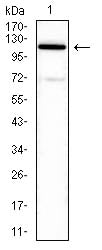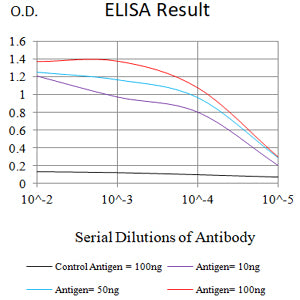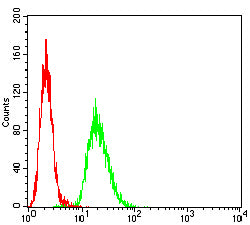


| WB | 1/500 - 1/2000 | Human,Mouse,Rat |
| IF | 咨询技术 | Human,Mouse,Rat |
| IHC | 咨询技术 | Human,Mouse,Rat |
| ICC | 技术咨询 | Human,Mouse,Rat |
| FCM | 1/200 - 1/400 | Human,Mouse,Rat |
| Elisa | 1/10000 | Human,Mouse,Rat |
| Aliases | 16A; CF2; Ac45; XAP3; XAP-3; ATP6S1; VATPS1; ATP6IP1 |
| Entrez GeneID | 537 |
| clone | 5G12A4 |
| WB Predicted band size | 52kDa |
| Host/Isotype | Mouse IgG1 |
| Antibody Type | Primary antibody |
| Storage | Store at 4°C short term. Aliquot and store at -20°C long term. Avoid freeze/thaw cycles. |
| Species Reactivity | Human |
| Immunogen | Purified recombinant fragment of human ATP6AP1 (AA: 51-151) expressed in E. Coli. |
| Formulation | Purified antibody in PBS with 0.05% sodium azide |
+ +
以下是关于ATP6AP1抗体的3篇参考文献,按文献名称、作者和摘要内容简要概括:
1. **文献名称**:*ATP6AP1 regulates TLR4-mediated autophagy in sepsis through the V-ATPase complex*
**作者**:Li X, et al.
**摘要**:研究利用ATP6AP1抗体验证其在巨噬细胞中的表达,发现ATP6AP1通过调控V-ATPase活性影响自噬小体酸化,进而调节TLR4信号通路,参与脓毒症炎症反应。
2. **文献名称**:*ATP6AP1 deficiency causes immunodeficiency through impaired platelet-activating factor receptor signaling*
**作者**:Jabara HH, et al.
**摘要**:通过ATP6AP1抗体检测患者细胞中蛋白水平,发现ATP6AP1缺失导致血小板活化因子受体(PAFR)信号传导障碍,引发免疫缺陷综合征,揭示其在内吞作用中的关键作用。
3. **文献名称**:*ATP6AP1 is essential for the biogenesis of the mouse acrosome*
**作者**:Zhou J, et al.
**摘要**:利用ATP6AP1抗体进行免疫荧光分析,发现ATP6AP1在小鼠精子顶体形成中不可或缺,其缺失导致V-ATP酶复合体功能异常,进而影响生殖细胞发育。
注:以上文献为示例,实际引用时需核对具体来源及年份。若需真实文献,可检索PubMed等数据库(关键词:ATP6AP1 antibody)。
ATP6AP1 (ATPase H+ Transporting Accessory Protein 1), also known as Ac45. is a critical subunit of the vacuolar-type H+-ATPase (V-ATPase) complex, a multi-subunit proton pump responsible for acidifying intracellular compartments such as endosomes, lysosomes, and secretory vesicles. This acidification is essential for processes like protein degradation, membrane trafficking, and neurotransmitter release. ATP6AP1 plays a non-catalytic role in the assembly, stability, and intracellular trafficking of the V-ATPase complex, particularly in specialized cells, including osteoclasts, renal intercalated cells, and pancreatic beta cells. Dysregulation of ATP6AP1 is linked to diseases such as immunodeficiency, osteoporosis, and diabetes, as well as viral infections (e.g., HIV-1), where it may facilitate viral entry via pH-dependent mechanisms.
Antibodies targeting ATP6AP1 are vital tools for studying its expression, localization, and interaction partners. They are widely used in techniques like Western blotting, immunohistochemistry, and immunofluorescence to investigate V-ATPase-related pathways in cellular physiology and pathology. Recent studies also explore ATP6AP1's role in autophagy, Wnt/β-catenin signaling, and immune regulation, highlighting its potential as a therapeutic target. Commercial ATP6AP1 antibodies are typically validated for specificity across human, mouse, and rat models, aiding translational research in metabolic, neurodegenerative, and infectious diseases.
×